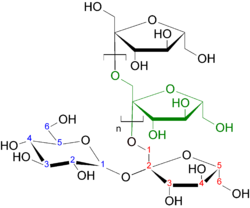A fructan is a polymer of fructose molecules. Fructans with a short chain length are known as fructooligosaccharides. Fructans occur in foods such as agave, artichokes, asparagus, leeks, garlic, onions(including spring onions), yacón, jícama, and wheat.
Fructans also appear in grass, with dietary implications for horses and other grazing animals (Equidae).

Structural formula of Inulins, linear fructans with a terminal α-D-glucose with 1→2 linkage
Types
Fructans are built up of fructose residues, normally with a sucrose unit (i.e. a glucose-fructose disaccharide) at what would otherwise be the reducing terminus. The linkage position of the fructose residues determine the type of the fructan. Linkage normally occurs at one of the two primary hydroxyls (OH-1 or OH-6), and there are two basic types of simple fructan:
- 1-linked: In Inulin, the fructosyl residues are linked by β-2,1-linkages.
- 6-linked: In Levan (or Phlein), the fructosyl residues are linked by β-2,6-linkages.
A third type of fructans, the graminan-type, contains both β-2,1-linkages and β-2,6-linkages.[1]
More complex fructans are formed on a 6G-kestotriose backbone where elongations occur on both sides of the molecule. Again two types are discerned:
- neo-inulin type: pre- dominant β-2,1-linkages
- neo-levan type: pre- dominant β-2,6-linkages
Functions
Fructans are important storage polysaccharides in the stems of many species of grassesand confer a degree of freezing tolerance.[2][3] A notable exception is rice, which is unable to synthesise fructans.[4]
Fructan content of various foods
Notes
- ^ Van den Ende, Wim (2013). "Multifunctional fructans and raffinose family oligosaccharides". Frontiers in Plant Science 4. doi:10.3389/fpls.2013.00247.
- ^ Pollock, C. J. (1986). "Tansley Review No. 5 Fructans and the Metabolism of Sucrose in Vascular Plants". New Phytologist 104: 1–0. doi:10.1111/j.1469-8137.1986.tb00629.x.
- ^ Pollock, C. J.; Cairns, A. J. (1991). "Fructan Metabolism in Grasses and Cereals". Annual Review of Plant Physiology and Plant Molecular Biology 42: 77. doi:10.1146/annurev.pp.42.060191.000453.
- ^ Kawakami, A.; Sato, Y.; Yoshida, M. (2008). "Genetic engineering of rice capable of synthesizing fructans and enhancing chilling tolerance". Journal of Experimental Botany 59(4): 793–802. doi:10.1093/jxb/erm367. PMID 18319240.
- ^ a b c d e f SUSAN J. SHEPHERD, M Nut Diet, APD*; PETER R. GIBSON, MD, MB, FRACP, "Fructose Malabsorption and Symptoms of Irritable Bowel Syndrome: Guidelines for Effective Dietary Management," J Am Diet Assoc 2006:106:1631-1639.[1]
- ^ a b Department of Food Science and Nutrition, University of Minnesota, Joanne L. Slavin, PhD, RD, "Mechanisms for the Impact of Whole Grain Foods on Cancer Risk," Journal of the American College of Nutrition, Vol. 19, No. 90003, 300S-307S (2000)[2]
- ^ Muir, J.G.; et al. (2007). "Fructan and Free Fructose Content of Common Australian Vegetables and Fruit". Journal of Agricultural and Food Chemistry 55: 6619–6627. doi:10.1021/jf070623x.
- ^ a b Karppinen, Sirpa. Dietary fibre components of rye bran and their fermentation in vitro. Espoo 2003. VTT Publications 500. 96 p. + app. 52 p.[3]
References
- Sugar - Chemical, Biological and Nutritional Aspects of Sucrose. John Yudkin, Jack Edelman and Leslie Hough (1971, 1973). The Butterworth Group. ISBN 0-408-70172-2
Wikipedia





No comments:
Post a Comment